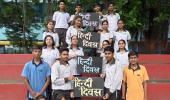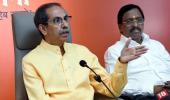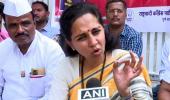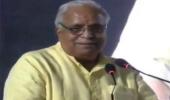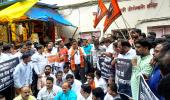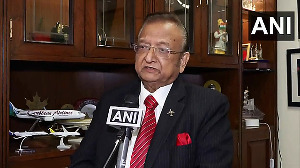'Maharashtrians are facing a dual battle -- numerical battle with North Indians and financial battle with Gujaratis and Marwaris.'
'This has created anxiety about survival and ownership over Mumbai and Maharashtra.'
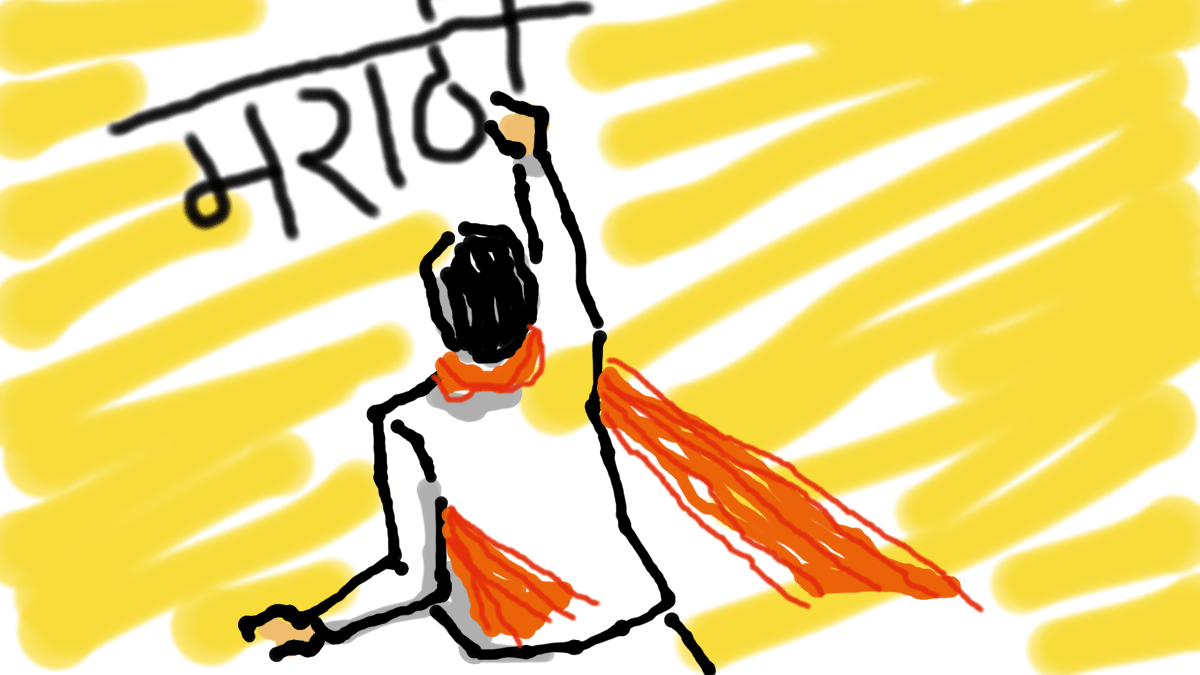
The Maharashtra government's recent resolution making Hindi as the third compulsory language along with Marathi and English from Classes 1 to 5 in all schools has sparked a sharp political and cultural backlash.
Citing alignment with the National Education Policy 2020, the move has been criticised for undermining regional languages.
Mahararashtra Navnirman Sena chief Raj Thackeray called it an 'imposition' and had demanded its immediate withdrawal, warning against sidelining Marathi in its own state.
With the Maharashtra government now issuing an order saying Hindi will 'generally' be taught as the third language to students in Marathi and English medium schools, Raj Thackeray has now asked the people of Maharashtra to foil the government's agenda to impose Hindi.
In this three-part interview with Prasanna D Zore/Rediff, Dr Deepak Pawar, president of the Marathi Abhyas Kendra and a prominent voice from Maharashtra's language rights movement, discusses the deeper implications of the Maharashtra government's decision to make Hindi mandatory for primary school children linking it to employment politics, cultural hegemony, and a looming threat to India's federal linguistic fabric.
Part One of the interview:
Maharashtra has a long tradition of linguistic identity movements -- Samyukta Maharashtra, the Shiv Sena's Marathi manoos campaigns.
How does that legacy influence public reaction to the State Curriculum Framework's Hindi compulsion for Std I to Standard V students in Maharashtra's schools?
If you look at the sequence of government decisions, they said they'd implement the CBSE syllabus. Then they clarified it's not the syllabus but NCERT textbooks.
Now, if you want to use NCERT textbooks, why not say so directly and try to upgrade the state board instead of confusing everyone?
Maharashtra today is facing a dual identity crisis. On one hand, we take pride in our 'Maha' prefix -- 'Maha'Rashtra, 'Maha'Agro, 'Maha'Nirmiti, 'Maha'Genko. But socially and politically, there is a deep degeneration.
So this is the moment to move beyond tokenism and reactionary language politics.
Given the legacy of the Marathi language I see collective anger against the state government's move to impose Hindi on the people of Maharashtra. But I see this anger as an opportunity to revisit the nature of Maharashtra's politics.
Whether we seize that opportunity -- or miss the bus again -- depends on how successfully we (the political class as well as other Maharashtrian stakeholders from society) consolidate and mobilise this anger for making Marathi language an instrument for employment generation.
From the way this imposition is being implemented it is clear that this is not an academic decision -- it's a political one.
The government is, in a way, creating an employment guarantee scheme for North Indians to become teachers.
There are many North Indians who've completed their BA and BEd in Hindi, and they're looking for jobs. Meanwhile, Marathi‑speaking graduates who are searching for jobs in English‑medium or other board‑affiliated schools think they'll benefit if Marathi is made compulsory -- but they're not assured of anything, whereas the North Indian boys and girls are assured employment.
The priority of this (Maharashtra) government (headed by the BJP‑NCP‑Shiv Sena) -- which has a brutal majority -- is to push forward the Hindi‑Hindu‑Hindustan agenda of the Government of India and the Sangh Parivar, which is the driving wheel behind both the Maharashtra and central governments.
Could you give us some backdrop of the anti‑Hindi movement in Maharashtra?
The anti‑Hindi movement (as different from anti-North Indian or anti-South Indian) in Maharashtra is comparatively a new phenomenon because, unlike Tamil Nadu or Andhra Pradesh or even Kerala, Maharashtra has always considered Hindi a language closer to Marathi.
That's basically because the Devanagari script (in which both Marathi and Hindi are written) is the same. This has been Maharashtra's history; it has this very self‑killing habit of going for the help of the Himalayas (Hindi‑speaking north India), and so many in Maharashtra (Maharashtrians) have adopted Hindi as just an extension of Marathi.
In Tamil Nadu or other southern states, the resistance to Hindi arose because the Constitution makers had said that after 15 years of implementing the Constitution, they would look to replace English with Hindi. So there was huge resistance, even violence -- almost the entire Tamil Nadu was in turmoil.
Compared to that, in Maharashtra, we hadn't seen any anti‑Hindi protests before 2000.
Anti‑Hindi protests started in Maharashtra only recently. But that protest is also about North Indian people, and not necessarily about the Hindi bhasha or language. Originally, the Shiv Sena had started its protest against South Indians because they thought South Indians were taking away clerical jobs.
By the time the MNS came to the political front, the organised sector in Maharashtra was almost dead. It was the informal (unorganised) sector and the services sector that had become important. And in that sector, the competition was between lower‑middle‑class Marathi manoos and lower‑middle‑class North Indians.
The lower‑middle‑class North Indians -- who had very limited expectations from social and economic life because of their background in Uttar Pradesh and Bihar -- were willing to work at any cost. So they took away jobs from Marathi‑speaking people.
And Raj Thackeray grabbed that opportunity and started the (anti-North Indian) agitation in 2006. It was also tacitly backed by the Congress-NCP-led government.
So lower‑middle‑class North Indians took over lower‑middle‑class Marathi jobs -- but only in the unorganised sector?
Yes, mostly in the unorganised sector.
Another area of anger was the non‑usage of Marathi in central government establishments -- like the railways, telephone services, and banks.
If you look at most nationalised banks, even those headquartered in Maharashtra like the Bank of Maharashtra, they would have forms or slips in only two languages -- English and Hindi -- but not Marathi. That was also a point of anger.
The Reserve Bank of India even issued circulars on this (that bank slips should also have information in Marathi on them). Sometimes, the Shiv Sena took the matter into its own hands. Even some parties from the South like the DMK raised the issue.
But this anger really surged after 2019, especially with the rise of the Hindi‑Hindu‑Hindustan narrative of the RSS becoming dominant in Maharashtra.
How deep is the feeling of anger in Maharashtra that this 'imposition' of Hindi on school children in Maharashtra is about cultural domination? What's the main cause for this anger?

You'll find that in the last six months to two years -- whether it's a chawl or an apartment in Mumbai and many other pockets in Maharashtra -- there have been incidents in semi‑urban and urban areas where North Indians are dominating and questioning why they should speak Marathi.
This has happened even with Gujaratis. Marathis and Gujaratis have clashed in several semi‑urban localities of Mumbai.
So Maharashtrians are facing a dual battle -- numerical battle with North Indians (when it comes to employment and jobs) and financial battle with Gujaratis and Marwaris (when it comes to setting up business establishments in Mumbai and other cities and towns).
This has created anxiety (in the minds of Marathi people) about their survival and their ownership over Mumbai, the MMR region (the Mumbai Metropolitan regions like Palghar, Kalyan, Panvel) and Maharashtra.
What is the RSS agenda in implementing Hindi across India?
It is Hindi, Hindu, Hindustan -- which means one nation, one language, one culture. That is the kind of monolithic identity they are interested in creating.
